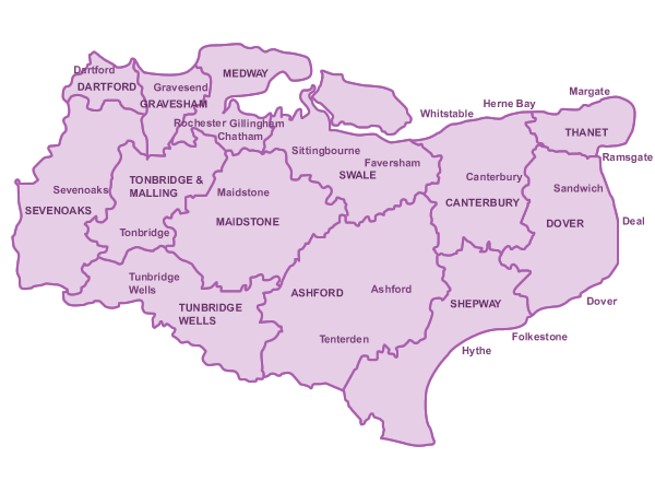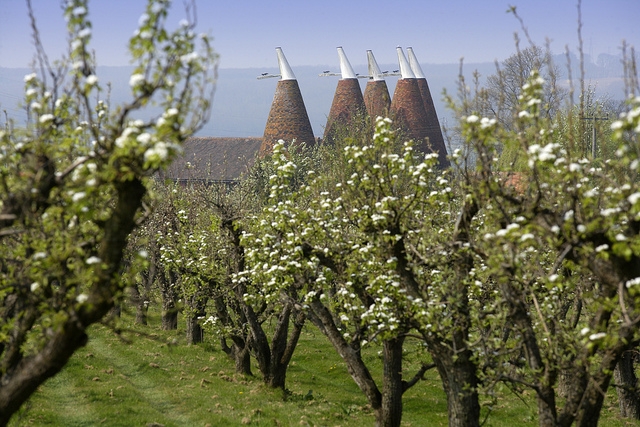Vi använder cookies för att webbplatsen ska fungera på ett bra sätt för dig. Genom att surfa vidare godkänner du att vi använder cookies.
Kent
- Location: Kent, Coast and catchments, South-east England
- Case Study Lead #1: Kent County Council
- Case Study Lead #2: Sayers and Partners
- Constituent Systems: Catchment, cities and coast
What is your case study about?
Kent has one of the highest numbers of properties at flood risk of any local authority in England. Currently, 15% of all households in the county are at risk of flooding. Sea level rise and increases in winter precipitation and the frequency, duration and intensity of heavy rainfall will increase flood risk across the county. More frequent and severe flooding is likely to increase recovery costs for homes and businesses, potentially leading to properties in some areas becoming uninsurable. Beyond their economic impacts, flood events can have a major impact on health, as well as property damage and loss.
Catchment partnerships have been established in Kent to better manage water systems through more coordinated joint action. However, although integrated solutions to climate adaptation and flooding are increasingly encouraged, important institutional barriers limit multi-sector collaboration across organisations working on engineered flood defences, nature-based solutions, and community resilience and preparedness. Through the C5a project, we further explore the development of a whole-of-system approach to managing flood risk by overcoming institutional barriers to collaboration among stakeholders.
A focus on inclusive and whole system approaches
An inclusive approach
With an inclusive approach, the Medway Flood Partnership brings together key stakeholders, namely local organisations, national agencies, non-governmental organizations, and communities to produce a Medway Flood Action Plan. Location-specific actions are developed through consensus to support communities to establish local flood forums and resilience plans. The Kent County Council (KCC) have worked with residents to develop a jointly owned flood incident plan and support communities during flood events, and the training and ongoing engagement with volunteer flood wardens have helped build residents’ awareness of risk and preparedness.
A whole system assessment of risk
With the whole-system approach, in the C5a workshop, KCC explored the institutional barriers to collaboration among organisations working on different aspects of flood management and emergency response. The development of a shared understanding of risk, the lack of evidence regarding the most effective types and locations for mitigation (especially nature-based) measures, and poor understanding of the long-term costs and benefits of different adaptation actions were all highlighted as barriers. The Kent Future Flood Explorer addresses all these issues to encourage a more holistic approach to adaptation.
An adaptive approach
With the adaptive approach, a key element of KCC’s adaptive approach has been to focus primarily on the immediate social and environmental benefits of adaptation to encourage political and public support.


What have been the benefits of applying those pillars?
An inclusive approach has ensured that the most at-risk communities not only understand the risks of flooding but that they also take an active role in mitigating that risk as they feel that they have actively participated in the development of resilience measures from the outset. The Medway Flood Action Plan is not an external document; it is something that they themselves have helped create along with the actions that stem from it. A whole-system approach is necessary to effectively adapt to climate change and manage flood risk, and the Kent Future Flood Explorer will make an important contribution to this by filling knowledge gaps relating to risk projections, evidence-based proposals for mitigation types and locations, and cost-benefit analyses of different measures. By focusing on the here and now benefits of adaptation measures beyond risk mitigation, we also foster greater support for long-term adaptation.
- The overall objective of the case study is to help overcome institutional barriers to multi-sector collaboration for climate change adaptation and flood risk management in Kent.
Christine Wissink
Promoting an inclusive approach

Left: Flood wardens drawn from the local community to support the local community. Right: Investment in local tourist opportunities and accessible beaches. Both copyright Kent County Council.
‘Is it okay to have an inclusive approach without an inclusive outcome?’ Questions Tom. ‘We may have an ineffective approach to inclusivity, but by saying that what we are doing is inclusive we can pat ourselves on the back and congratulate ourselves, even if people, the most marginalised, are still not participating. Inclusive approach needs revising if it does not lead to inclusive outcomes.’
The socially most vulnerable tend to be the most exposed to climate risks and also those with the poorest understanding of climate and flood risk. At KCC, adaptation projects we carried out in the past tended to assume a level of public understanding that simply didn’t exist, significantly weakening our ability to actively engage and incorporate the most socially marginalised and vulnerable in adaptation measures.
Reducing flood risk in the Medway catchment – Kent’s largest catchment – is a complex problem that can only be solved by wholistic and coordinated work with residents (many of whom live in some of the most marginalised communities of the county), community organisations, public bodies, and the private sector. KCCs work in the Medway catchment is attempting to tackle this knowledge barrier to participating in adaptation decision-making through the development of a more inclusive approach to mitigating flood risk. There are a range of coordinated actions required in the catchment to help manage the risk of flooding, including investing in new and improved traditional engineered flood defences, natural flood management measures that slow and store floodwater, and community resilience and preparedness measures that reduce the impact of flooding on communities.
The Medway Flood Partnership, established in January 2017, plays an important role in this by bringing together local people and organisation, national agencies, non-governmental organisations and community representatives to develop and produce a Medway Flood Action Plan. Within the Plan, an inclusive approach to engagement and community involvement is key. These process as been build upon through C5a convened workshops to share knowledge and lessons, with a series of core messages emerging:
- Need for location-specific actions, developed through consensus, to support communities to establish local flood forums in high risk communities and develop local resilience plans. The Co-design of actions to be taken were based initially on community engagement and presentation of the risks to communities and possible actions that could be taken to mitigate them – achieved through participation workshops and consensus building.
- The importance of working with residents to develop a jointly owned flood incident plan, to include road closures, to support communities during flood events. Road closures are now better understood and implemented as a result of community engagement.
- The recruitment, training and maintained engagement with new and existing volunteer flood wardens and helped local communities to build residents’ awareness of their individual flood risk and what they can do to prepare and respond.
Everyone has a role in preparing for and responding to flooding. Over the coming years, C5a together with ongoing initiatives such as the Medway Catchment Partnership will setting the foundation to help communities to develop their plans further and consider the 25 year vision and the pathway to getting there. This is a continuous process that will continue beyond c5a through the Medway Partnership to ensure actions are delivered and plan updated and new information and ideas are incorporated.
Promoting a whole system understanding
A C5a workshop with stakeholders from across Kent explored the institutional barriers to collaboration among organisations working on different aspects of flood management and emergency response. The workshop highlighted the need for a shared understanding of risk in the county, the lack of evidence to assess the most effective types and locations for mitigation (especially nature-based) measures, and the long-term costs and benefits of different adaptation options.
Understanding how flood risk (at the coastal, along the rivers and surface water in the towns and cities) may development across the region is a pre-requisite to developing plans and actions to address those risks. This can be a complex task, with alternative climate change and socio-economic development making the choice of the best flood risk management adaptation polices difficult determine. Within Kent, the Future Flood Explorer provides a window on present day exposure to flooding, taking account of social vulnerability, and how these risks may change under a 2 and 4 degrees rise in Global Mean Surface Temperature, low and high socio-economic growth projections and alternative adaptation portfolios (assuming a continuation or current policy as well as an enhanced and reduced adaptation effort). The chance in risk and the benefits of adaptation vary across Kent. The Kent FFE illustrates this and how robust adaptation choices can be made (that work well cross multiple futures). In doing so, evidence on the present and flood risk given alternative pathways helps provides the ‘push’ to action. To self-explore the climate related flood risks in Kent (read more) in support of county level climate change risk assessment, available to download (link).
Promoting an adaptive approach
Example of the Adaptation Catalyst dashboard that provides an overview of the sequence of adaptation measures, theirs costs and effectiveness
Adapatation has been and continues to be a focus for Kent and progress has made in building climate change adaptation into long-term decision-making processes.
Through pilot studies (tree planting to manage heat stress and surface water flood risk) an adaptation catalyst tool designed to aid professionals in delivering local action to adapt to climate change – downloadable from Publicwiki, a rainwater harvesting tool to help polytunnel fruit growers across the county quantify the water saving and financial benefits of using or increasing rainwater harvesting on their farms) and knowledge-sharing through participation in a number of adaptation focused EU Interreg projects in addition to C5a (STAR2Cs, H2O Source2Seas and Cool Towns), KCC has developed a more holistic approach to adaptation that seeks to combine technical innovations and advances in our knowledge of climate change projections and risks, with clear and effective social engagement at all levels, from our political representatives and decision-makers to our diverse communities. Climate adaptation has for too long been considered a technical problem requiring technical solutions, with little consideration of social dynamics other than as a potential obstacle to measures designed and implemented from the top-down. However, through actively and effectively (this is more difficult!) engaging with communities and residents from the outset of adaptation projects to their completion, KCC has seen an improved understanding of climate risks, greater support for adaptation, and greater recognition of the authorities’ adaptation work at the national level.
One of the biggest obstacles that KCC has faced in terms of increasing climate resilience across the county has been the lack of understanding of climate risks, of the need for adaptation, and what adaptation actually means and looks like in practice. This lack of understanding extends from communities to the private sector and decision makers at all levels and across diverse sectors. One of the most effective ways of overcoming this lack of understanding, which contributes to a widespread belief that climate change is a future problem that will need to be addressed in years to come, not in the here and now, has been to focus on the wider benefits of actions rather than their core adaptation purpose. A key element of KCC’s adaptive approach therefore has been to focus primarily on the immediate social and environmental benefits of the adaptation work that we carry out, rather than the adaptation benefits which, for us at KCC, are the priority.






